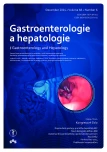Recommended procedure for diagnosis and treatment of chronic hepatitis B
Authors:
P. Husa 1; J. Šperl 2; P. Urbánek 3; S. Plíšek 4; P. Kümpel 5; L. Rožnovský 6
Authors‘ workplace:
Společnost infekčního lékařství ČLS JEP
; Česká hepatologická společnost ČLS JEP
; Slezská nemocnice Opava6 Klinika infekčního lékařství LF OU a FN Ostrava
Published in:
Gastroent Hepatol 2014; 68(6): 514-526
Category:
Hepatology: Best Practises
doi:
https://doi.org/10.14735/amgh2014514
Společnost infekčního lékařství ČLS JEP Česká hepatologická společnost ČLS JEP
Overview
The new recommendations reflect the growth in knowledge that has been reported since the release of the previous Czech guidelines in April 2009. According to qualified estimates, there are 350–400 million people with chronic hepatitis B (HBV) infection worldwide. The Czech Republic is one of the countries with a low prevalence of HBV infection. According to latest seroprevalence study, 0.56% of Czech citizens were chronically infected with HBV in 2001. HBV infection can lead to serious life-threatening liver damage (fulminant hepatitis), liver cirrhosis and hepatocellular carcinoma (HCC). The goal of the treatment is to prolong the length of life and improve quality of life by preventing the progression of chronic hepatitis to cirrhosis, cirrhosis decompensation and development of HCC. This goal can be achieved if HBV replication can be suppressed in a sustained manner. The subsequent reduction in histological activity reduces the risk of cirrhosis and HCC, particularly in non-cirrhotic patients. Currently, there are two different strategies of chronic hepatitis B therapy available – time-limited or long-term treatment. The time-limited therapy can be done using pegylated interferon (PEG-IFN), entecavir (ETV), or tenofovir (TDV). A 48-week course of PEG-IFN is mainly recommended for HBeAg-positive patients with the best chance of anti-HBe seroconversion. Limited ETV or TDV treatment is achievable for HBeAg-positive patients who seroconvert to anti-HBe upon treatment. However, the treatment duration cannot be predicted prior to the therapy as it depends on the timing of anti-HBe seroconversion and the treatment continuation post anti-HBe seroconversion (therapy should be continued for another 12 months after anti-HBe seroconversion). Long-term ETV or TDV therapy is necessary for HBeAg-positive patients who do not develop anti-HBe seroconversion and for HBeAg-negative patients. This strategy is also recommended for patients with cirrhosis, irrespective of the initial HBeAg status or anti-HBe seroconversion on treatment. The advantages of ETV and TDV are their high potency and optimal resistance profile.
The authors declare they have no potential conflicts of interest concerning drugs, products, or services used in the study.
The Editorial Board declares that the manuscript met the ICMJE „uniform requirements“ for biomedical papers.
Submitted:
30. 9. 2014
Accepted:
20. 10. 2014
Sources
1. Husa P, Plíšek S, Šperl J et al. Diagnostika a léčba chronické hepatitidy B. Doporučený postup ČHS a SIL ČLS JEP. Datum vydání doporučení: duben 2009. Klin Mikrobiol Inf Lék 2009; 15(2): 65–76.
2. Husa P, Plíšek S, Šperl J et al. Diagnostika a léčba chronické hepatitidy B. Doporučený postup ČHS a SIL ČLS JEP. Datum vydání doporučení: duben 2009. Prakt Lék 2009; 89(4): 167–176.
3. European Association for the Study of the Liver. EASL clinical practice guidelines: management of chronic hepatitis B virus infection. J Hepatol 2012; 57(1): 167–185. doi: 10.1016/j.jhep.2012.02.010.
Labels
Paediatric gastroenterology Gastroenterology and hepatology SurgeryArticle was published in
Gastroenterology and Hepatology

2014 Issue 6
Most read in this issue
- OVESCO clip as a solution of an ERCP complication
- An infrequent source of gastrointestinal bleeding
- Karlovy Vary gastroenterological – this year for the thirteenth time
- Vedolizumab – a novel anti-integrin antibody with high gastrointestinal selectivity
